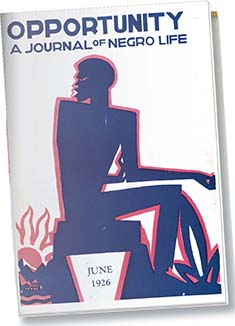SECTION 5: The Harlem Renaissance

◄ Magazines like this one focused on African American culture and history.
WITNESS HISTORY  AUDIO
AUDIO
The Excitement of Harlem
In the early 1920s, the New York City neighborhood known as Harlem was the most vibrant African American community in the nation. Teeming with people and teeming with activity, it was also, as one observer noted, “a great magnet for the Negro intellectual.” Among those who were drawn to Harlem was a young Missouri-born poet named Langston Hughes. He later recalled what he felt like as he stepped off the subway:
“I can never put on paper the thrill of the underground ride to Harlem. I went up the steps and out into the bright September sunlight. Harlem! I stood there, dropped my bags, took a deep breath and felt happy again.”
—Langston Hughes, The Big Sea
Objectives
- Analyze the racial and economic philosophies of Marcus Garvey.
- Trace the development and impact of jazz.
- Discuss the themes explored by writers of the Harlem Renaissance.
Terms and People
- Marcus Garvey
- jazz
- Louis Armstrong
- Bessie Smith
- Harlem Renaissance
- Claude McKay
- Langston Hughes
- Zora Neale Hurston
NoteTaking
Reading Skill: Identify Main Ideas As you read, identify the main ideas.
- New “Black Consciousness”
- New Chances, New Challenges
- Migration to North continues
Why It Matters As a result of World War I and the Great Migration, millions of African Americans relocated from the rural South to the urban North. This mass migration continued through the 1920s and contributed to a flowering of music and literature. Jazz and the Harlem Renaissance made a lasting impact, not only on African Americans but on the culture all Americans share. Section Focus Question: How did African Americans express a new sense of hope and pride?
A New “Black Consciousness”
Like the immigrants who traveled from Europe and Asia, African Americans who left the South dreamed of a better future. They had heard stories of economic opportunity, social advancement, and greater political rights. The South, they reasoned, was a dead end. Locked into low-paying rural jobs, barred from decent schools, faced with the reality of Jim Crow oppression and the threat of lynching, they pointed their compasses north.
Migrants Face Chances and Challenges
Most African American migrants to the north probably found a better life. Wages in a Detroit auto plant or a Pittsburgh steel mill were far better than what a sharecropper earned in the South. In such cities as New York, Chicago, Pittsburgh, and Cleveland, African Americans had a growing political voice. In those towns, there also existed black middle and upper classes. African American ministers, physicians, lawyers, teachers, and journalists practiced their professions and served as role models to the younger generation.




